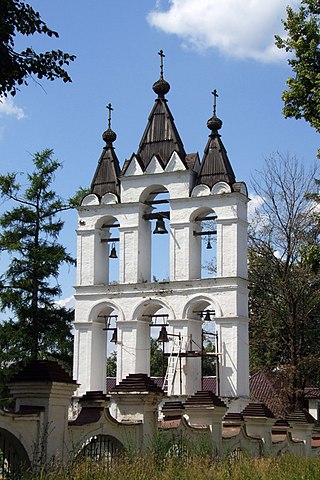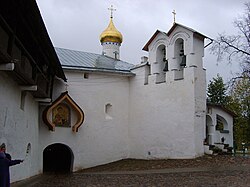Zvonnitsa
Structure for hanging bells From Wikipedia, the free encyclopedia
A zvonnitsa (Russian: звонница,[1] pl. звонницы, zvonnitsy; Ukrainian: дзвіниця, romanized: dzvinytsia; Polish: dzwonnica parawanowa; Romanian: zvoniţă) is a large rectangular structure containing multiple arches or beams that support bells, and a basal platform where bell ringers stand to perform the ringing using long ropes. It was an alternative to a bell tower in Russian, Polish and Romanian medieval architectural traditions, primarily used in Russian architecture of the 14th–17th centuries. Currently, zvonnitsy are especially widespread in the environs of Pskov.

Unlike bell towers in Western Europe, zvonnitsy in Russia were generally built of brick rather than stone.[2] As a result, they were structurally weaker, which led to new solutions in the 19th-century to address issues with structural support and sufficient suspension of the bells.[2]
Sometimes, zvonnitsy were mounted directly on church roofs, resulting in a special form of church called a pod zvonom (Russian: под звоном, lit. 'under ringing') or izhe pod kolokoly (иже под колоколы, 'under bells'). The most famous example of this type is the Church of St Ivan of the Ladder, adjacent to Ivan the Great Bell Tower in the Moscow Kremlin.
In Polish, the word dzwonnica refers to any type of bell tower, while the fortified trellis construction containing apertures for bells is referred to by the term dzwonnica parawanowa.
Examples
- Borisoglebsky Monastery, Borisoglebsky, Yaroslavl Oblast
- Church of St. Nicholas, Pskov-Caves Monastery, Pskov
- Church of St. George the Victorious, Pskov
- Assumption Cathedral, Rostov Kremlin, Rostov
See also
References
Sources
External links
Wikiwand - on
Seamless Wikipedia browsing. On steroids.






